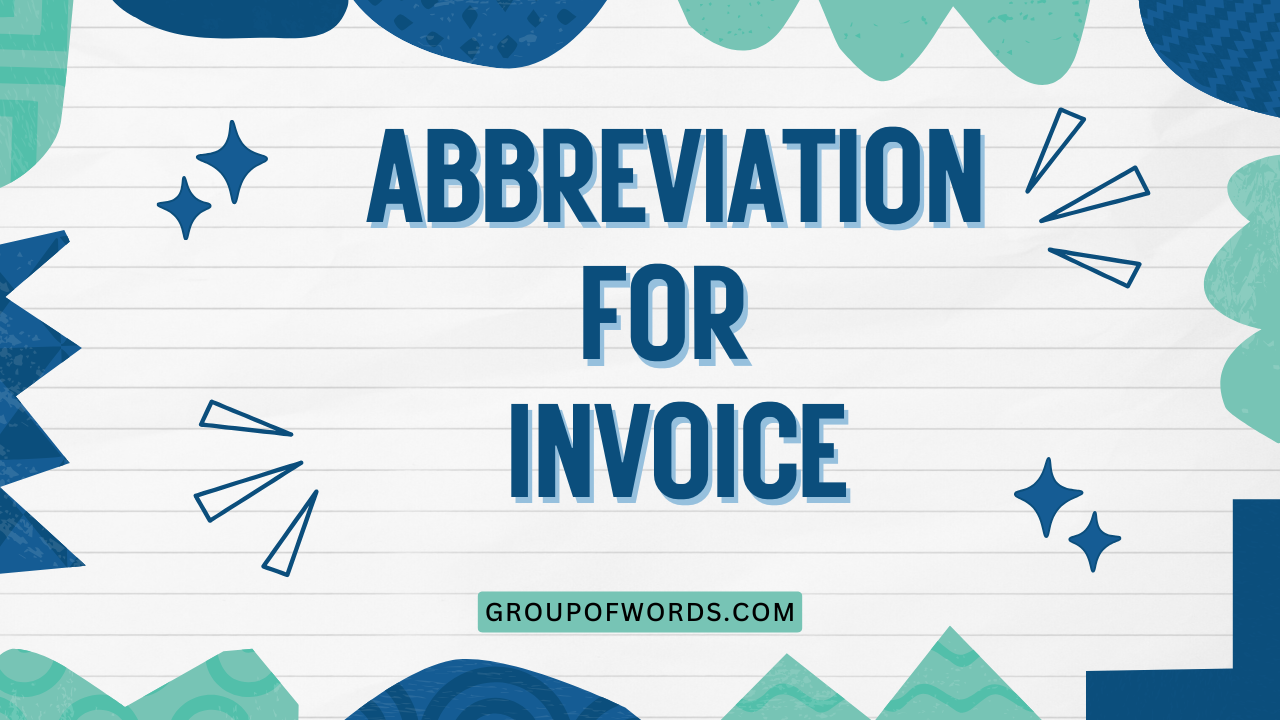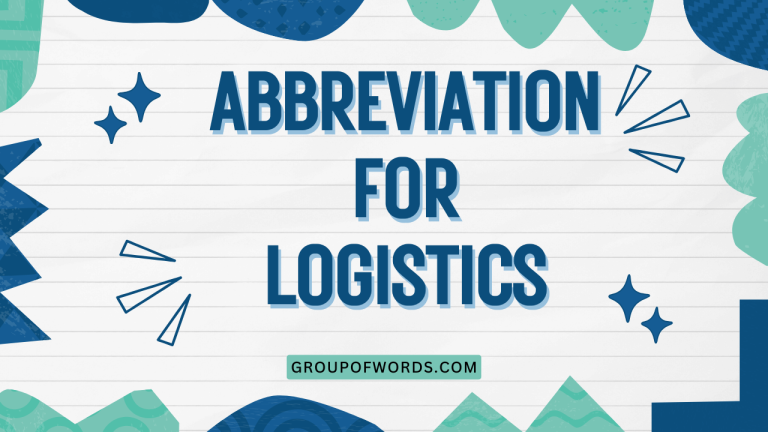Invoice Abbreviations: A Comprehensive Guide
Understanding invoice abbreviations is crucial for anyone involved in business, accounting, or even personal finance. These abbreviations streamline communication, save time, and ensure clarity in financial documents.
This article provides a detailed exploration of common invoice abbreviations, their meanings, and proper usage. Whether you’re a seasoned professional or just starting out, mastering these abbreviations will enhance your understanding of invoices and improve your efficiency in handling financial transactions.
Table of Contents
- Introduction
- Definition of Invoice Abbreviations
- Structural Breakdown of Invoice Abbreviations
- Types and Categories of Invoice Abbreviations
- Examples of Invoice Abbreviations
- Usage Rules for Invoice Abbreviations
- Common Mistakes with Invoice Abbreviations
- Practice Exercises
- Advanced Topics
- Frequently Asked Questions (FAQ)
- Conclusion
Introduction
In the world of business and finance, efficiency and clarity are paramount. Invoice abbreviations are a key component of this efficiency, allowing for quick and concise communication of important information.
These abbreviations appear on invoices, receipts, and other financial documents, and understanding them is essential for accurate record-keeping and financial management. This guide will provide a comprehensive overview of invoice abbreviations, covering their definitions, usage, and common pitfalls.
This article is designed for a wide audience, including business owners, accountants, bookkeepers, students, and anyone who regularly deals with invoices. By mastering the concepts presented here, you’ll be able to confidently interpret invoices, avoid misunderstandings, and streamline your financial processes.
We’ll explore various types of abbreviations, provide real-world examples, and offer practical exercises to reinforce your learning.
Definition of Invoice Abbreviations
An invoice abbreviation is a shortened form of a word or phrase commonly used on invoices to save space and time. These abbreviations are designed to convey specific information quickly and efficiently.
They can refer to various aspects of an invoice, such as payment terms, discounts, shipping methods, and product descriptions. Understanding these abbreviations is critical for accurately interpreting the information presented on an invoice.
Invoice abbreviations can be classified into several categories based on their function. Some abbreviations refer to payment terms (e.g., Net 30, EOM), while others describe discounts (e.g., COD, EARLY PMT). Still others relate to shipping (e.g., FOB, CIF) or product information (e.g., QTY, UNIT PRICE). The context in which an abbreviation appears usually provides clues to its meaning, but it’s always best to be familiar with common abbreviations to avoid confusion.
Classification of Invoice Abbreviations
Invoice abbreviations can be classified based on what aspect of the invoice they relate to. This classification helps in understanding the context and meaning of the abbreviation.
- Payment Terms: These abbreviations specify the time frame within which payment is expected. Examples include Net 30, EOM (End of Month), and PIA (Payment in Advance).
- Discount Terms: These abbreviations indicate any discounts offered for early payment or other reasons. Examples include COD (Cash on Delivery), and EARLY PMT (Early Payment).
- Shipping Terms: These abbreviations describe the terms of shipment, including who is responsible for shipping costs and insurance. Examples include FOB (Free on Board), and CIF (Cost, Insurance, and Freight).
- Product Information: These abbreviations relate to the products or services being invoiced, such as quantity, unit price, and descriptions. Examples include QTY (Quantity), and UNIT PRICE.
- General Terms: These are abbreviations for common accounting and business terms. Examples include A/R (Accounts Receivable) and A/P (Accounts Payable).
Function of Invoice Abbreviations
The primary function of invoice abbreviations is to streamline communication and save space on invoices. By using abbreviations, businesses can convey important information concisely and efficiently.
This is particularly important in situations where invoices need to be processed quickly or stored in a compact format. Abbreviations also help to reduce errors by providing a standardized way to represent common terms and conditions.
Another important function of invoice abbreviations is to ensure consistency across different invoices and departments. By using a standard set of abbreviations, businesses can avoid confusion and ensure that everyone is on the same page.
This is especially important in large organizations where invoices may be processed by multiple people or departments. Standardized abbreviations also facilitate automation of invoice processing, as software can be programmed to recognize and interpret them automatically.
Contexts of Invoice Abbreviations
Invoice abbreviations are used in a variety of contexts, including:
- Sales Invoices: These are invoices issued by a seller to a buyer for goods or services provided.
- Purchase Invoices: These are invoices received by a buyer from a seller for goods or services purchased.
- Accounting Systems: Accounting software uses invoice abbreviations to streamline data entry and reporting.
- Financial Statements: Invoice abbreviations may appear in financial statements to summarize key financial information.
- Contracts: Contracts may reference invoice abbreviations to define payment terms and other conditions.
Structural Breakdown of Invoice Abbreviations
Understanding the structure of invoice abbreviations can help you decipher their meaning more easily. Most invoice abbreviations are formed by taking the first letter or letters of each word in a phrase. For example, “Cash on Delivery” is abbreviated as COD. Some abbreviations may also include numbers or symbols to further clarify their meaning. For example, “Net 30” indicates that payment is due within 30 days.
The structure of an invoice abbreviation can also depend on the specific industry or company using it. Some industries may have their own set of standard abbreviations that are not widely used elsewhere.
Similarly, some companies may create their own abbreviations for internal use. It’s important to be aware of these variations and to consult a glossary or reference guide if you encounter an unfamiliar abbreviation.
Elements of Invoice Abbreviations
Invoice abbreviations typically consist of the following elements:
- Acronyms: These are abbreviations formed from the initial letters of a series of words, such as FOB (Free on Board).
- Initialisms: Similar to acronyms, but the letters are pronounced individually, such as EOM (End of Month).
- Truncations: These are shortened forms of words, such as QTY (Quantity).
- Numeric Indicators: Numbers used to specify timeframes or percentages, such as Net 30 (payment due in 30 days) or 2/10 Net 30 (2% discount if paid within 10 days, otherwise net due in 30 days).
Patterns in Invoice Abbreviations
Recognizing common patterns in invoice abbreviations can help you understand their meaning more quickly. Some common patterns include:
- First Letter Abbreviation: Taking the first letter of each word (e.g., COD for Cash on Delivery).
- Key Word Abbreviation: Abbreviating the most important words in a phrase (e.g., EARLY PMT for Early Payment).
- Numeric Combination: Combining letters with numbers to indicate timeframes or percentages (e.g., Net 30).
Rules for Forming Invoice Abbreviations
While there are no strict rules for forming invoice abbreviations, some general guidelines are followed:
- Clarity: The abbreviation should be easily understood and unambiguous.
- Consistency: The same abbreviation should be used consistently throughout all invoices and documents.
- Industry Standards: Follow industry-standard abbreviations whenever possible.
- Avoid Over-Abbreviation: Don’t use too many abbreviations, as this can make the invoice difficult to understand.
Types and Categories of Invoice Abbreviations
Invoice abbreviations can be categorized based on the type of information they convey. This categorization helps in understanding the context and meaning of the abbreviation.
Payment Terms Abbreviations
Payment terms abbreviations specify the terms of payment, including the time frame within which payment is expected. These abbreviations are crucial for managing cash flow and ensuring timely payments.
- Net 30: Payment is due within 30 days of the invoice date.
- Net 60: Payment is due within 60 days of the invoice date.
- EOM: End of Month – Payment is due at the end of the month in which the invoice was issued.
- PIA: Payment in Advance – Payment is required before the goods or services are provided.
- 2/10 Net 30: A 2% discount is offered if payment is made within 10 days; otherwise, the full amount is due within 30 days.
Discount Terms Abbreviations
Discount terms abbreviations indicate any discounts offered for early payment or other reasons. These abbreviations can help buyers save money and encourage them to pay invoices promptly.
- COD: Cash on Delivery – Payment is due upon delivery of the goods.
- EARLY PMT: Early Payment – A discount is offered for early payment.
- QTY DISC: Quantity Discount – A discount is offered for purchasing a large quantity of goods.
- TRADE DISC: Trade Discount – A discount offered to customers in the same industry.
- CASH DISC: Cash Discount – A discount offered for paying in cash.
Shipping Terms Abbreviations
Shipping terms abbreviations describe the terms of shipment, including who is responsible for shipping costs and insurance. These abbreviations are important for determining the total cost of goods and services.
- FOB: Free on Board – The seller is responsible for delivering the goods to a specified location, after which the buyer assumes responsibility.
- CIF: Cost, Insurance, and Freight – The seller is responsible for the cost of goods, insurance, and freight to a specified destination.
- EXW: Ex Works – The buyer is responsible for all costs and risks associated with transporting the goods from the seller’s premises.
- DDP: Delivered Duty Paid – The seller is responsible for all costs and risks associated with delivering the goods to the buyer’s premises, including import duties.
- FCA: Free Carrier – The seller delivers the goods to a carrier specified by the buyer at a named place.
Product Information Abbreviations
Product information abbreviations relate to the products or services being invoiced, such as quantity, unit price, and descriptions. These abbreviations are essential for accurately tracking inventory and calculating the total amount due.
- QTY: Quantity – The number of units being invoiced.
- UNIT PRICE: The price of a single unit.
- DESC: Description – A brief description of the product or service.
- SKU: Stock Keeping Unit – A unique identifier for each product.
- UOM: Unit of Measure – The standard unit for measuring the product (e.g., each, kg, liter).
General Accounting and Business Term Abbreviations
These are abbreviations for common accounting and business terms that may appear on invoices.
- A/R: Accounts Receivable – The amount of money owed to a business by its customers.
- A/P: Accounts Payable – The amount of money a business owes to its suppliers.
- PO: Purchase Order – A document authorizing a purchase.
- INV: Invoice – A bill for goods or services.
- REF: Reference – A reference number or code.
Examples of Invoice Abbreviations
This section provides extensive examples of invoice abbreviations, organized by category. These examples will help you understand how abbreviations are used in real-world invoices and financial documents.
Payment Terms Examples
The following table provides examples of payment terms abbreviations and their meanings.
| Abbreviation | Meaning | Example |
|---|---|---|
| Net 30 | Payment due within 30 days | “Please remit payment within Net 30 days.” |
| Net 60 | Payment due within 60 days | “Our payment terms are Net 60.” |
| EOM | End of Month | “Payment is due EOM.” |
| PIA | Payment in Advance | “PIA is required for all new customers.” |
| 2/10 Net 30 | 2% discount if paid within 10 days, otherwise net due in 30 days | “We offer 2/10 Net 30 terms.” |
| Net 45 | Payment due within 45 days | “The invoice is payable within Net 45 days.” |
| CBD | Cash Before Delivery | “CBD required for all international orders.” |
| CIA | Cash in Advance | “CIA terms apply to all custom orders.” |
| Due Upon Receipt | Payment is due immediately upon receiving the invoice | “Payment is Due Upon Receipt of this invoice.” |
| Mo. Due | Month Due | “The total balance is Mo. Due.” |
| 1/15 Net 30 | 1% discount if paid within 15 days, otherwise net due in 30 days | “Take advantage of our 1/15 Net 30 offer.” |
| Net 7 | Payment due within 7 days | “Payment is expected within Net 7 days.” |
| Net 10 | Payment due within 10 days | “Please process payment within Net 10 days.” |
| E.O.M. + 10 | End of Month plus 10 days | “Payment is due E.O.M. + 10 days.” |
| E.O.M. + 15 | End of Month plus 15 days | “Our payment terms are E.O.M. + 15 days.” |
| E.O.M. + 30 | End of Month plus 30 days | “The balance is due E.O.M. + 30 days.” |
| 30 Days Net | Payment is due 30 days after the invoice date. | “The invoice must be paid within 30 Days Net.” |
| 60 Days Net | Payment is due 60 days after the invoice date. | “We offer 60 Days Net payment terms.” |
| 90 Days Net | Payment is due 90 days after the invoice date. | “Payment is required within 90 Days Net.” |
| Net D | Net Daily; Payment due daily | “All invoices are settled Net D.” |
| Due on Rec. | Due on Receipt | “This invoice is Due on Rec.” |
| Immed. Payment | Immediate Payment | “Immed. Payment is required for cash sales.” |
| St. Mo. Due | Start of Month Due | “Payment is St. Mo. Due.” |
| 15th Prox. | Payment due on the 15th of the following month | “Payment is due by 15th Prox.” |
| 25th Prox. | Payment due on the 25th of the following month | “Payment is due by 25th Prox.” |
| Net 20 | Payment due within 20 days | “Please remit payment within Net 20 days.” |
These examples illustrate the various ways payment terms abbreviations are used on invoices to specify payment deadlines and conditions.
Discount Terms Examples
The following table provides examples of discount terms abbreviations and their meanings.
| Abbreviation | Meaning | Example |
|---|---|---|
| COD | Cash on Delivery | “COD orders must be paid upon delivery.” |
| EARLY PMT | Early Payment Discount | “We offer an EARLY PMT discount.” |
| QTY DISC | Quantity Discount | “A QTY DISC is applied for bulk orders.” |
| TRADE DISC | Trade Discount | “Wholesalers receive a TRADE DISC.” |
| CASH DISC | Cash Discount | “A CASH DISC is available for cash payments.” |
| 2/10, n/30 | 2% discount if paid within 10 days, net amount due in 30 days | “Terms: 2/10, n/30” |
| 5/10, n/60 | 5% discount if paid within 10 days, net amount due in 60 days | “We offer 5/10, n/60 payment terms.” |
| Disc. | Discount | “Total after Disc.: $450” |
| Vol. Disc. | Volume Discount | “Vol. Disc. applied for large purchases.” |
| Promo Disc. | Promotional Discount | “Promo Disc. applied during the sale.” |
| Loyalty Disc. | Loyalty Discount | “Loyalty Disc. given to frequent customers.” |
| Staff Disc. | Staff Discount | “Staff Disc. available for employees.” |
| Cust. Disc. | Customer Discount | “Cust. Disc. applied to the invoice.” |
| Disc. % | Discount Percentage | “Disc. %: 10%” |
| Spec. Disc. | Special Discount | “Spec. Disc. offered for a limited time.” |
| Seasonal Disc. | Seasonal Discount | “Seasonal Disc. applied during the holidays.” |
| Price Red. | Price Reduction | “Price Red. due to clearance sale.” |
| Rebate | Partial refund after purchase | “Rebate of $50 after purchase.” |
| Early Bird Disc. | Early Bird Discount | “Early Bird Disc. for first 100 customers.” |
| Student Disc. | Student Discount | “Student Disc. available with ID.” |
| Senior Disc. | Senior Discount | “Senior Disc. offered for age 65+.” |
| New Cust. Disc. | New Customer Discount | “New Cust. Disc. for first-time buyers.” |
| Referral Disc. | Referral Discount | “Referral Disc. when friends sign up.” |
| Online Disc. | Online Discount | “Online Disc. applied for web orders.” |
| Bulk Disc. | Bulk Discount | “Bulk Disc. for purchasing over 100 items.” |
| Member Disc. | Member Discount | “Member Disc. for club members.” |
These examples demonstrate the different types of discounts that may be offered on invoices and how they are abbreviated.
Shipping Terms Examples
The following table provides examples of shipping terms abbreviations and their meanings.
| Abbreviation | Meaning | Example |
|---|---|---|
| FOB | Free on Board | “FOB Destination” |
| CIF | Cost, Insurance, and Freight | “CIF to New York” |
| EXW | Ex Works | “EXW Factory” |
| DDP | Delivered Duty Paid | “DDP Buyer’s Address” |
| FCA | Free Carrier | “FCA Shipping Terminal” |
| C&F | Cost and Freight | “C&F to Port of Entry” |
| FAS | Free Alongside Ship | “FAS Port of Loading” |
| CPT | Carriage Paid To | “CPT Destination City” |
| CIP | Carriage and Insurance Paid To | “CIP Final Destination” |
| DAT | Delivered at Terminal | “DAT Designated Terminal” |
| DAP | Delivered at Place | “DAP Agreed Location” |
| LTL | Less than Truckload | “Shipped via LTL” |
| FTL | Full Truckload | “Shipped via FTL” |
| Exp. Ship | Expedited Shipping | “Exp. Ship available at extra cost” |
| Std. Ship | Standard Shipping | “Std. Ship is the default option” |
| O/N | Overnight Shipping | “O/N delivery guaranteed” |
| 2-Day Air | Two-Day Air Shipping | “2-Day Air option available” |
| Gnd. Ship | Ground Shipping | “Gnd. Ship takes 3-5 business days” |
| Free Ship | Free Shipping | “Free Ship on orders over $100” |
| Ins. | Insurance | “Ins. cost included in shipping fees” |
| Hndlg. | Handling | “Hndlg. fee applies to all orders” |
| Delivery Chg. | Delivery Charge | “Delivery Chg. added to the total” |
| P&P | Postage and Packing | “P&P costs are non-refundable” |
| S&H | Shipping and Handling | “S&H fees vary by location” |
| Collect Freight | Freight charges to be paid by the recipient | “Shipping via Collect Freight” |
These examples illustrate the different shipping terms that may be specified on invoices and how they are abbreviated.
Product Information Examples
The following table provides examples of product information abbreviations and their meanings.
| Abbreviation | Meaning | Example |
|---|---|---|
| QTY | Quantity | “QTY: 10” |
| UNIT PRICE | Price per unit | “UNIT PRICE: $10.00” |
| DESC | Description | “DESC: Widget Model X” |
| SKU | Stock Keeping Unit | “SKU: WID-X-123” |
| UOM | Unit of Measure | “UOM: each” |
| Item No. | Item Number | “Item No.: 45678” |
| Prod. Code | Product Code | “Prod. Code: ABC-001” |
| Cat. No. | Catalog Number | “Cat. No.: 98765” |
| Part No. | Part Number | “Part No.: XYZ-543” |
| Serial No. | Serial Number | “Serial No.: 123456789” |
| Model No. | Model Number | “Model No.: DEF-987” |
| List Price | List Price | “List Price: $25.00” |
| RRP | Recommended Retail Price | “RRP: $30.00” |
| Net Price | Net Price | “Net Price: $20.00” |
| Taxable | Subject to Tax | “Taxable: Yes” |
| Exempt | Exempt from Tax | “Exempt: No” |
| Weight | Weight | “Weight: 1.5 kg” |
| Size | Size | “Size: Medium” |
| Color | Color | “Color: Blue” |
| Material | Material | “Material: Cotton” |
| Specs | Specifications | “Specs: See attached datasheet” |
| Warranty | Warranty | “Warranty: 1 year” |
| Origin | Country of Origin | “Origin: USA” |
| UPC | Universal Product Code | “UPC: 012345678901” |
| EAN | European Article Number | “EAN: 9780123456789” |
These examples showcase the various types of product information that may be included on invoices and how they are abbreviated.
Usage Rules for Invoice Abbreviations
Using invoice abbreviations correctly is essential for clear and accurate communication. Here are some key usage rules to follow:
- Use Standard Abbreviations: Stick to widely recognized and accepted abbreviations to avoid confusion.
- Be Consistent: Use the same abbreviation consistently throughout all invoices and documents.
- Provide Context: If using an abbreviation that may not be familiar to everyone, provide context or a definition.
- Avoid Ambiguity: Choose abbreviations that are clear and unambiguous, avoiding abbreviations that could have multiple meanings.
- Consider Your Audience: Tailor your use of abbreviations to your audience’s level of familiarity.
Exceptions to the Rules
There are some exceptions to the general rules for using invoice abbreviations:
- Industry-Specific Abbreviations: Certain industries may have their own unique set of abbreviations that are widely used within that industry.
- Company-Specific Abbreviations: Some companies may use their own internal abbreviations, but these should be clearly defined and documented.
- Informal Invoices: In informal situations, such as invoicing a friend or family member, you may be more flexible with your use of abbreviations.
Special Cases and Considerations
Here are some special cases and considerations to keep in mind when using invoice abbreviations:
- International Invoices: Be aware that abbreviations may vary in meaning or usage across different countries.
- Automated Systems: Ensure that your automated accounting systems are configured to correctly interpret and process invoice abbreviations.
- Legal Documents: When dealing with legal documents, it’s best to avoid abbreviations altogether and spell out all terms in full.
Common Mistakes with Invoice Abbreviations
Even experienced professionals can make mistakes with invoice abbreviations. Here are some common errors to avoid:
- Using Unrecognized Abbreviations: Using abbreviations that are not widely known or understood.
- Inconsistent Usage: Using different abbreviations for the same term on different invoices.
- Ambiguous Abbreviations: Using abbreviations that could have multiple meanings.
- Over-Abbreviation: Using too many abbreviations, making the invoice difficult to understand.
- Ignoring Context: Failing to consider the context in which an abbreviation is used.
Correct vs. Incorrect Examples:
| Incorrect | Correct | Explanation |
|---|---|---|
| PMT DUE 30 | Net 30 | “Net 30” is the standard abbreviation for payment due in 30 days. |
| SHPNG | SHIP | “SHIP” is a more common and recognizable abbreviation for shipping. |
| QNTY | QTY | “QTY” is the standard abbreviation for quantity. |
| EOM PAYMENT | EOM | “EOM” is the standard abbreviation for End of Month. |
| ADVANCE PMT | PIA | “PIA” is the standard abbreviation for Payment in Advance. |
Practice Exercises
Test your knowledge of invoice abbreviations with these practice exercises.
- What does “Net 30” mean?
- What does “COD” stand for?
- What does “FOB” mean?
- What does “QTY” stand for?
- What does “EOM” mean?
- What does “PIA” stand for?
- What does “UNIT PRICE” mean?
- What does “DESC” stand for?
- What does “SKU” stand for?
- What does “A/R” stand for?
- What does “A/P” mean?
- What does “PO” stand for?
- What does “INV” mean?
- What does “REF” stand for?
- What does “CIF” mean?
Answer Key:
- Payment due within 30 days
- Cash on Delivery
- Free on Board
- Quantity
- End of Month
- Payment in Advance
- Price per unit
- Description
- Stock Keeping Unit
- Accounts Receivable
- Accounts Payable
- Purchase Order
- Invoice
- Reference
- Cost, Insurance, and Freight
Advanced Topics
For advanced learners, here are some more complex aspects of invoice abbreviations to consider:
- Negotiating Payment Terms: Understanding how to negotiate favorable payment terms with suppliers and customers.
- Using Abbreviations in Contracts: Incorporating invoice abbreviations into contracts and legal agreements.
- Automating Invoice Processing: Implementing automated systems to process invoices and extract data from abbreviations.
- Custom Abbreviations: Creating custom abbreviations for internal use within your organization.
- International Variations: Researching and understanding the variations in invoice abbreviations across different countries and cultures
Frequently Asked Questions (FAQ)
What is the most common invoice abbreviation?
The most common invoice abbreviation is likely “QTY” for Quantity, as it appears on nearly every invoice that involves the sale of goods.
Are invoice abbreviations universally recognized?
While many invoice abbreviations are widely recognized, some may be specific to certain industries or regions. It’s always best to clarify the meaning of any unfamiliar abbreviations.
How can I create my own invoice abbreviations?
When creating your own invoice abbreviations, prioritize clarity, consistency, and conciseness. Ensure that the abbreviations are easily understood by your intended audience and document them clearly for future reference.
What should I do if I encounter an unfamiliar invoice abbreviation?
If you encounter an unfamiliar invoice abbreviation, consult a comprehensive glossary of invoice abbreviations, ask the issuer of the invoice for clarification, or search online for the abbreviation’s meaning.
Can using too many abbreviations on an invoice be a problem?
Yes, using too many abbreviations can make an invoice difficult to understand and may lead to errors or misunderstandings. It’s best to strike a balance between conciseness and clarity.
Are there any legal implications to using invoice abbreviations?
While invoice abbreviations are generally acceptable, it’s important to ensure that they are clearly defined and understood by all parties involved. In legal documents, it’s generally best to avoid abbreviations altogether and spell out all terms in full to prevent any ambiguity.
How do invoice abbreviations differ across industries?
Invoice abbreviations can vary significantly across different industries. For example, the construction industry may use abbreviations related to materials and labor, while the retail industry may use abbreviations related to discounts and promotions.
It’s important to be familiar with the common abbreviations used in your specific industry.
How can I stay up-to-date with new invoice abbreviations?
Staying up-to-date with new invoice abbreviations requires continuous learning and awareness. Subscribe to industry publications, attend relevant conferences and workshops, and network with other professionals in your field to stay informed about the latest trends and developments.
What role do invoice abbreviations play in accounting software?
Invoice abbreviations play a crucial role in accounting software by streamlining data entry, facilitating automated processing, and ensuring consistency across different records. Accounting software is often programmed to recognize and interpret common invoice abbreviations, making it easier to manage financial transactions.
Are there any ethical considerations when using invoice abbreviations?
Yes, there are ethical considerations to keep in mind when using invoice abbreviations. Always use abbreviations honestly and transparently, and avoid using them in a way that could mislead or deceive others.
Be clear and upfront about the meaning of any abbreviations you use, and be willing to provide clarification if needed.
Conclusion
Mastering invoice abbreviations is essential for anyone involved in business and finance. By understanding the definitions, usage rules, and common pitfalls associated with these abbreviations, you can improve your efficiency, accuracy, and communication skills.
Whether you’re processing invoices, managing accounts, or negotiating payment terms, a solid understanding of invoice abbreviations will help you succeed in today’s fast-paced business environment. Remember to stay updated with industry standards and always prioritize clarity and consistency in your use of abbreviations.






